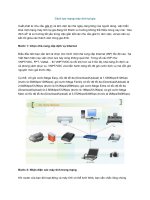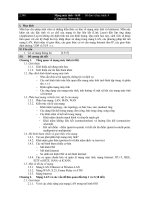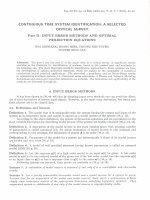Tài liệu ôn tập mạng máy tính KHTN
Bạn đang xem bản rút gọn của tài liệu. Xem và tải ngay bản đầy đủ của tài liệu tại đây (3.7 MB, 108 trang )
MẠNG MÁY TÍNH
1
I. Yêu cầu kiến thức
1. Topology
Đồ hình mạng (network topology):
cách thức bố trí đường truyền để nối kết các nút mạng
Phân loại:
Đồ hình vật lí : Mơ tả cách bố trí đường truyền thật sự
Đồ hình logic: Mơ tả con đường mà dữ liệu thật sự di chuyển.
Các kiểu đồ hình mạng:
Bus: các thiết bị nối trực tiếp vào một đường mạng chung
Star: các thiết bị nối trực tiếp vào một thiết bị chung
Ring: các thiết bị nối với nhau tạo thành vòng tròn
Mesh: 2 thiết bị bất kì được nối trực tiếp với nhau
Bus
Use of cable is economical.
Media is inexpensive & easy to
work with.
System is simple and reliable.
Bus is easy to extend.
Network can slow down
in heavy
traffic.
Problems are difficult to
isolate.
Cable break can affect
many users
Ring
System provides equal access
for all computers. Performance
is even despite many users.
Failure of one computer
can impact
the rest of the network.
Problems are hard to
isolate. Network
reconfiguration disrupts
operation.
2
Star
Modifying system and adding
new
computers is easy. Centralized
monitoring and management
are
possible. Failure of one
computer
does not affect the rest of the
network.
If the centralized point
fails, the network fails.
Mesh
System provides increased
redundancy and reliability as
well as ease of troubleshooting.
System is expensive to
install because it uses a
lot of cabling.
3
2. Protocol
Giao thức:
Hiểu: như là một “thống nhất” giữa các “đối tượng” khi trao đổi thông tin
qui định, qui tắc để trao đổi dữ liệu giữa các đối tượng trên mạng
•
Định dạng dữ liệu trao đổi (syntax, semantic)
•
Thứ tự thơng tin truyền nhận giữa các thực thể trên mạng
•
Các hành động cụ thể sau mỗi sự kiện nhận/gởi hay 1 sự kiện nào đó xảy ra
VD: HTTP, TCP, IP, PPP, …
Do các tổ chức và hiệp hội xây dựng: IEEE, ANSI, TIA, EIA, ITU-T
3. Network Devices
4
4. Bandwidth
Băng thơng (bandwidth):
Lượng thơng tin có thể truyền đi trên 1 kết nối mạng trong 1 khoảng thời gian
Lý tưởng
Đơn vị tính: bit/s (bps), Mbps, Gbps, …
4 reasons to understanding
Bandwidth is finite
Bandwidth is not free
Bandwidth is a key factor in analyzing network performance, designing new networks, and
understanding the Internet.
The bandwidth is ever increasing
5
5. Throughtput
Thông lượng (throughput):
Băng thông thực tế
Nhỏ hơn nhiều so với băng thông lý thuyết
Các yếu tố ảnh hưởng:
–
Thiết bị liên mạng
–
Topology mạng
–
Số lượng user trên mạng
–
Máy tính của user, server
–
…
Throughput refers to actual measured bandwidth, at a specific time of day, using specific Internet
routes, and while a specific set of data is transmitted on the network.
Factors that determine throughput
Type of data being transferred
Network topology
Number of users on the network
User computer
Server computer
Power conditions
6
–
Radio, television, and telephone transmissions have, until recently, been sent through the air and
over wires using electromagnetic waves. These waves are called analog because they have the same
shapes as the light and sound waves produced by the transmitters. As light and sound waves change
size and shape, the electrical signal that carries the transmission changes proportionately. In other
words, the electromagnetic waves are analogous to the light and sound waves. Analog bandwidth is
7
measured by how much of the electromagnetic spectrum is occupied by each signal. The basic unit
of analog bandwidth is hertz (Hz), or cycles per second. Typically, multiples of this basic unit of
analog bandwidth are used, just as with digital bandwidth. Units of measurement that are
commonly seen are kilohertz (KHz), megahertz (MHz), and gigahertz (GHz). These are the units used
to describe the bandwidths of cordless telephones, which usually operate at either 900 MHz or 2.4
GHz. These are also the units used to describe the bandwidths of 802.11a and 802.11b wireless
networks, which operate at 5 GHz and 2.4 GHz.
–
While analog signals are capable of carrying a variety of information, they have some significant
disadvantages in comparison to digital transmissions. The analog video signal that requires a wide
frequency range for transmission cannot be squeezed into a smaller band. Therefore, if the
necessary analog bandwidth is not available, the signal cannot be sent.
–
In digital signaling all information is sent as bits, regardless of the kind of information it is. Voice,
video, and data all become streams of bits when they are prepared for transmission over digital
media. This type of transmission gives digital bandwidth an important advantage over analog
bandwidth. Unlimited amounts of information can be sent over the smallest or lowest bandwidth
digital channel. Regardless of how long it takes for the digital information to arrive at its destination
and be reassembled, it can be viewed, listened to, read, or processed in its original form.
–
It is important to understand the differences and similarities between digital and analog bandwidth.
Both types of bandwidth are regularly encountered in the field of information technology. However,
because this course is concerned primarily with digital networking, the term ‘bandwidth’ will refer to
digital bandwidth.
8
6. Lan/Man/Wan/San
Theo địa hình
Mạng cục bộ (LAN – Local Area Network)
Kích thước nhỏ (tồ nhà, phịng máy, cơng ty, ..)
Thuộc 1 đơn vị, 1 tổ chức
Tốc độ cao, ít lỗi
Rẻ tiền
Mạng đô thị (MAN - Metropolean Area Network)
Nhiều mạng LAN kết hợp lại
Có phạm vi trong 1 quận, huyện, thành phố
Thuộc 1 đơn vị, 1 tổ chức
Chậm, nhiều lỗi, chi phí cao hơn LAN
9
Mạng diện rộng (WAN - Wide Area Network)
Nhiều LAN, MAN kết hợp với nhau
Phạm vi quốc gia, châu lục, quốc tế
Thuộc nhiều đơn vị, 1 tổ chức
Chậm, nhiều lỗi, chi phí cao hơn LAN, MAN
10
•
SAN (Storage – Area Networks)
o A SAN is a dedicated, high-performance network used to move data between servers and
storage resources. Because it is a separate, dedicated
network, it avoids any traffic conflict between clients
and servers.
o SAN technology allows high-speed server-to-storage,
storage-to-storage, or server-to-server connectivity.
Internet
This method uses a separate network infrastructure
that relieves any problems associated with existing
network connectivity.
o SANs offer the following features:
o Performance – SANs enable concurrent access of disk
or tape arrays by two or more servers at high speeds,
Storage-area
providing enhanced system performance.
Network
o Availability – SANs have disaster tolerance built in,
because data can be mirrored using a SAN up to 10
kilometers (km) or 6.2 miles away.
o Scalability – Like a LAN/WAN, it can use a variety of
technologies. This allows easy relocation of backup
data, operations, file migration, and data replication
between systems.
11
7. Intranet – extranet
Theo phạm vi hoạt động:
intranet
•
Nội bộ trong 1 đơn vị
extranet
•
Intranet
•
Cho phép bên ngồi truy cập vào thơng qua chứng thực
internet
•
Cho phép bên ngồi truy cập
One common configuration of a LAN is an Intranet. Intranet Web servers differ from public Web
servers in that the public must have the proper permissions and passwords to access the Intranet of
an organization. Intranets are designed to permit access by users who have access privileges to the
internal LAN of the organization. Within an Intranet, Web servers are installed in the network.
Browser technology is used as the common front end to access information such as financial data or
graphical, text-based data stored on those servers.
Extranets refer to applications and services that are Intranet based, and use extended, secure access
to external users or enterprises. This access is usually accomplished through passwords, user IDs,
and other application-level security. Therefore, an Extranet is the extension of two or more Intranet
strategies with a secure interaction between participant enterprises and their respective intranets.
12
Intranets and Extranets
Intranet VPN
Intranet VPN
Company A
Extranet VPN
Company A
Company B
13
8. VPN
–
–
–
A VPN is a private network that is
constructed within a public network
infrastructure such as the global
Internet. Using VPN, a telecommuter
can access the network of the
company headquarters through the
Internet by building a secure tunnel
between the telecommuter’s PC and
a VPN router in the headquarters.
IPIPnetwork
network
VPN
Cisco products support the latest in
VPN technology. A VPN is a service
that offers secure, reliable
connectivity over a shared public
network infrastructure such as the
Internet. VPNs maintain the same
security and management policies as
a private network. They are the most
cost-effective method of establishing Head Quarter
a point-to-point connection between
remote users and an enterprise customer's network.
Branch
SOHO
Telecommuter
The following are the three main types of VPNs:
Access VPNs – Access VPNs provide remote access to a mobile worker and small
office/home office (SOHO) to the headquarters of the Intranet or Extranet over a shared
infrastructure. Access VPNs use analog, dialup, ISDN, digital subscriber line (DSL), mobile
IP, and cable technologies to securely connect mobile users, telecommuters, and branch
offices.
Intranet VPNs – Intranet VPNs link regional and remote offices to the headquarters of the
internal network over a shared infrastructure using dedicated connections. Intranet
VPNs differ from Extranet VPNs in that they allow access only to the employees of the
enterprise.
Extranet VPNs – Extranet VPNs link business partners to the headquarters of the network
over a shared infrastructure using dedicated connections. Extranet VPNs differ from
Intranet VPNs in that they allow access to users outside the enterprise
14
15
9. Unicast/Broadcast/Multicast
Kiểu truyền:
Unicast
Từ 1 node đến 1 node
Broadcast
Từ 1 node đến tất cả các node trong một vùng mạng
Multicast
Từ 1 node đến 1 nhóm
Anycast
Từ 1 node đến 1 node bất kỳ trong một nhóm
16
10. Các độ trễ gửi gói tin
Là thời gian trễ của 1 gói tin
Các nguyên nhân gây ra trễ:
Trễ do tốc độ truyền (transmission delay)
Trễ trên đường truyền (propagation delay)
Xử lí tại nút (nodal processing)
Hàng đợi (queuing delay)
Trễ do tốc độ truyền (transmission delay):
Là thời gian cần thiết để chuyển mạch hết gói tin lên đường truyền
Dtrans = L/R (s)
–
R = băng thông của đường truyền (bps)
–
L = chiều dài gói tin (bit)
Ví dụ: gói tin có chiều dài L = 100bytes. Đường truyền có băng thơng R = 10 Mbps
Dtrans = 100 / 10
Trễ trên đường truyền (propagation delay)
Thời gian truyền 1 bit từ nơi gởi đến nơi nhận
Dprop = d/c
–
d = chiều dài đường truyền
17
–
c = tốc độ truyền (~ 2x108 m/sec - 3x108 m/sec)
Xử lý tại nút (nodal processing): Dproc
Là thời gian xử lý header của 1 gói tin và quyết định chuyển mạch gói tin theo hướng nào
–
Kiểm lỗi bit
–
Xác định đầu ra (vd dựa trên địa chỉ đến.)
Thường rất nhỏ
Hàng đợi: Dqueue
Là thời gian gói tin chờ trong hàng đợi để được đưa lên đường truyền
Phụ thuộc: số lượng gói tin đến trước nó
Tổng độ trễ khi truyền 1 gói tin:
D = Dproc + Dqueue + Dtrans + Dprop
Các lệnh dùng để kiểm tra thời gian trễ
Ping
Tracert
Pathping
11. LAN media
12. WAN services
13. Networking Models
–
The concept of layers is used to describe communication from one computer to another. Figure
shows a set of questions that are related to flow, which is defined as the motion through a system of
either physical or logical objects. These questions show how the concept of layers helps describe the
details of the flow process. This process could be any kind of flow, from the flow of traffic on a
highway system to the flow of data through a network. Figure shows several examples of flow and
ways that the flow process can be broken down into details or layers.
–
A conversation between two people provides a good opportunity to use a layered approach to
analyze information flow. In a conversation, each person wishing to communicate begins by creating
an idea. Then a decision is made on how to properly communicate the idea. For example, a person
18
could decide to speak, sing or shout, and what language to use. Finally the idea is delivered. For
example, the person creates the sound which carries the message.
–
This process can be broken into separate layers that may be applied to all conversations. The top
layer is the idea that will be communicated. The middle layer is the decision on how the idea is to be
communicated. The bottom layer is the creation of sound to carry the communication.
14. Communication Process characteristic
Communication characteristics
•
Addresses
–
•
Media
–
•
Who are the source and the destination of a communication process?
Where is the communication take place?
Protocols
–
is a set of rules how to make communication on a network more efficient.
Phương thức truyền dữ liệu:
chuyển mạch mạch (circuit-switching):
Mỗi “cuộc gọi” chiếm 1 tài nguyên nhất định
Yêu cầu thiết lập đường dẫn trước
Chiếm giữ tài nguyên suốt “cuộc gọi”
Đảm bảo không bị nghẽn mạch
Sử dụng băng thông không hiệu quả nếu dữ liệu rời rạc (hoặc dày đặc nhưng bit rate không
đều)
Khắc phục:
Nhập nhiều “cuộc gọi” trên cùng 1 đường truyền
19
kỹ thuật: FDMA (tần số theo trục ngang, đồng thời), TDMA (tần số theo trục dọc, lần lượt
từng gói)
VD: mạng điện thoại PSTN
chuyển mạch gói (packet-switching)
Mỗi luồng dữ liệu được chia nhỏ thành các gói
Các gói tin chia sẻ chung tài nguyên mạng
Mỗi gói sử dụng tồn bộ băng thơng
cho phép nhiều người dùng đồng thời hơn
Bị tắt nghẽn
Yêu cầu tài nguyên sử dụng vừa đủ
Mỗi gói có thêm phần “header” làm tăng kích thước dữ liệu truyền
Phù hợp cho dữ liệu tức thời
VD: mạng máy tính
20
15. Proxy
Proxy
Là 1 ứng dụng đặc biệt
“Thay thế” các kết nối
16. Firewall
Bức tường lửa (Firewall):
Bảo vệ hệ thống
Kiểm sốt luồng dữ liệu
•
từ mạng bên trong đi ra ngồi
•
Từ bên ngoài đi vào mạng bên trong
Phần mềm/phần cứng
21
17. Virus/Worms/Malware/Backdoor
22
18. IPv4 address, subnetting
Tầng 3 trong mơ hình OSI
Kích thước: 4 bytes (32 bits)
Định dạng:
Mỗi byte được biểu diễn bằng số thập phân, gọi là một octet
hai octet được viết cách nhau bằng 1 dấu chấm “.”
VD:
172.29.1.10
Chia thành 2 phần:
Network ID (NetID)
Host ID
32 bit
23
Phân loại:
Địa chỉ public:
•
dùng để trao đổi trên Internet
•
Địa chỉ thật
Địa chỉ private
•
Dùng để đánh địa chỉ cho các mạng LAN bên trong 1 tổ chức
•
Địa chỉ ảo
Địa chỉ loopback: 127.0.0.0 – 127.255.255.255
24
Chia subnet:
Mục tiêu:
giảm số lượng node Tăng thông lượng mạng
Tăng tính bảo mật
Dễ quản trị
Dễ bảo trì
Tránh lãng phí địa chỉ IP
25









